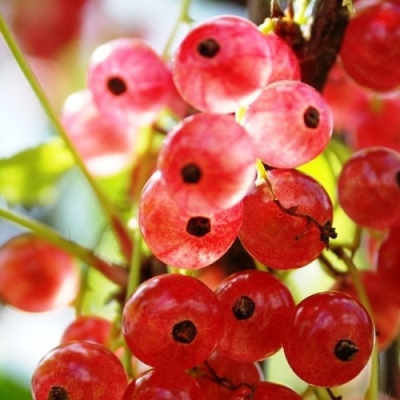
- Authors: Canada
- Ripening terms: early maturing
- Growth type: medium-sized
- Yield: high
- Appointment: universal
- Berry weight, g: 0,9 – 1
- Escapes: old shoots lignified, pale brown in color
- Sheet: large, three- or five-lobed, green in color, with small teeth and notches, the surface is matte, wrinkled, leathery, covered with fluff in the lower part
- Flowers: white, medium-sized, bisexual
- Brush: loose
When it is impossible to choose between red or white currants, it is best to pay attention to Pink Pearls. Including the best qualities of both, it has a sweeter taste and a larger size. This variety is especially appreciated for its versatility in its application: this variety of berries serves as the basis for many desserts.
Breeding history
In the wild, pink currant does not exist. This variety was artificially bred by Canadian breeders in the 80s of the last century. The hybrid combines the best qualities of red and white currants.
Description of the variety
The bushes are sprawling, have dense foliage, reach heights of up to 1.2 m, have an average thickening, which reliably protects young shoots from sunburn. The plant is self-fertile.
Characteristics of berries
The berries weigh about 1.3 g and are round in shape. The juicy pulp is covered with a pink transparent skin. The currant does not crumble, it is removed by dry separation. Ripe has a light aroma. The berries are formed in clusters of 8-12 pieces. The size of the brushes reaches 12 cm.
Taste qualities
The berries have a sweet and sour taste. A feature of this variety is a very slight acidity, which sets off the main sweet taste.
Ripening and fruiting
The variety belongs to the early maturing. Ripening of the entire crop occurs simultaneously by mid-July - early August, 70 days after pollination. The variety has long-term fruiting.

Yield
High yields are achieved in 3 years of cultivation. Usually, from 3 to 8 kg are removed from one bush.
Growing regions
The most favorable for growing this variety are the southern regions, the Far East, the regions of the middle belt, Siberia, the Urals, the Moscow region.
Landing
When planting, it is required to select places with sufficient sunlight. The selected place should not be exposed to the cold wind: this can harm the seedlings. Loam and sandy loam are most favorable for planting this variety. Depleted soil should be fertilized with organic matter. The nutrient mixture should be applied directly to the planting hole. Planting is carried out by cuttings.

Growing and care
The plant is easy to care for.It has an average resistance to disease and pest infestation. The bush is not picky about watering and soil acidity. The branched root system successfully supplies the plant with the necessary moisture and micronutrients. It is enough to water it 1-2 times a week.
During the season, 2-3 additional feeding is required.
Sanitary pruning of old, dried branches should be carried out regularly, giving the shrub a beautiful shape.





Currant is one of the most favorite crops of gardeners, it can be found on almost any personal plot. In order for the currant berries to be tasty and large, and the bush itself to be healthy and strong, you should properly care for, treat and protect the plant from harmful insects. It is important to recognize the signs of the disease in a timely manner and begin treatment in the early stages of plant damage.
Resistance to adverse climatic conditions
With high frost resistance (up to - 29 degrees), the plant does not tolerate spring temperature drops, frost is especially detrimental to them, therefore it is recommended to cover it during this period.
The snowless frosty winters can also harm the plant. In this case, the plant should be covered.

Review overview
Gardeners note a high degree of survival of cuttings, easy care of the plant.
An attractive decorative appearance of shrubs with rich greenness of carved leaves and pale pink color of berries, which can serve as decoration for the fence of the site or be used for zoning, is also important.
Pay attention to the refined taste of the berry and the wide dessert purpose of this variety. It is good in jelly, jam, jelly, mousse, fruit drinks, compotes. It is used as a filling in baked goods.
The possibility of using berries not only on the day of picking, but also for several days is also valuable. Berries, collected by tassels, being in a cool place, do not lose their taste and presentation.









































































